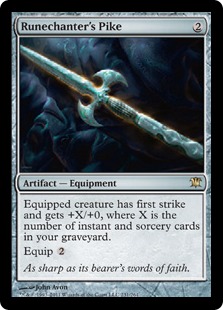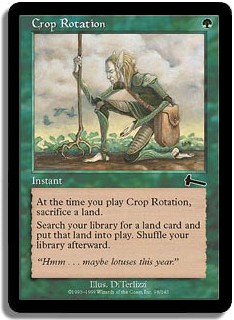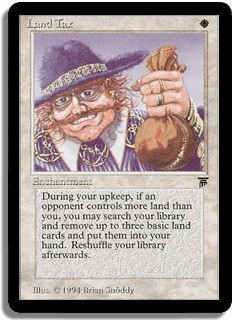This past weekend in Detroit gave us some shake-ups in both Standard and Legacy, as Delver and Griselbrand started to release their death grips on both formats, respectively. Chris Andersen and Ari Lax showed us that moving closer and closer to Solar Flare is the next natural evolution for a deck that started with four Phantasmal Bears right smack in the middle of the “creatures” section on the decklist. Who could have predicted that? Well, it goes back to a fundamental theory of deck evolution in established formats: the best deck will tend to get more inbred and slower step-by-step, week-by-week as more players try to gain an edge in the mirror. Â
Though I was about seven years old when this occurred, I’ve read enough articles to know that StarCityGames.com own Mike Flores famously tuned his Rebels deck in Masques Block Constructed to contain more and more controlling elements as the season wore on. This, for me, is the first time I can recall a deck being designed to go one step slower to try to out-control the mirror match. I’m sure it happened before, but it bears reiterating: in a pseudo-mirror match, you do not want to be the beatdown. Resources invariably get traded off when both decks have all the same cards, and the player with the last trump or the most cards wins.
This evolution happened more recently with pre-Alara Reborn B/W Tokens, which started playing more and more Wrath of Gods as the season wore on to answer opposing Cloudgoat Rangers and Spectral Processions and bait out two for ones. It was also been a big deal in the Jund mirror match, where players started playing more lands, more high-end spells such as Broodmate Dragon, and more mana acceleration to get those big game-enders out there sooner.Â
The problem with modifying one’s deck to slow it down for the mirror match is that it frequently comes at the cost of significant matchup percentage against other decks which were always most vulnerable to aggressive starts from these “best decks.” Putrid Leech may not have been flashy, but playing that card on turn 2 rather than a Rampant Growth went a long way towards beating U/W Tap-Out Control, Naya, or Mythic. Tidehollow Sculler in B/W Tokens was important for beating up on control and Faeries, even though cutting it for Wrath of God made a lot of sense in the mirror.
Likewise, cutting Delver of Secrets dramatically changes the dynamic of the Esper Midrange versus Solar Flare matchup. Now what used to be the Delver deck is no longer able to put Flare off-balance the whole game and force it to react awkwardly since there is no more early game pressure. The whole game becomes a value battle where cards like Nihil Spellbomb and Sun Titan are trumps, and the midrange deck has to get up on cards with Snapcaster Mage and Restoration Angel before the Flare deck can dump a bunch of Titans on the table. It truly is a head-scratching matchup since there are so many decisions, so many good answers to all of the threats, and so few ways to convincingly end a game.Â
This favors the skilled player, which is why it’s unsurprising to see Chrandersen and Ari both making Top 4 with the deck. It also means that Delver players can ditch the transformative sideboard while still beating R/G and Naya, since now the late-game trumps that were formerly relegated to the fifteen on the bench are in the starting 60! I like Ari Lax list a good amount, although I would probably want to play more Doom Blades and fewer Gut Shots maindeck. Here’s his list, for reference:
Creatures (16)
Planeswalkers (1)
Lands (23)
Spells (20)

Meanwhile, now that we’ve talked about how Esper Midrange is the natural evolution for Delver decks in order to win the semi-mirrors that abound at a Standard tournament, players like Adam Boyd and Yuuya Watanabe are slimming down their Delver lists and getting about as aggressive as Delver can possibly get! What’s going on here? Well, there’s a simple answer, and that is that once Delver players have slowed down their decks just a notch too much, a savvy player can dial the aggression way up to come in and beat the tar out of these inbred dinosaurs.
You can only edge so far towards control before you become a slow Solar Flare deck, and the adoption of Blade Splicer in Delver is heralding that tipping point. Now players who want to can just get as aggressive as possible, preying on the minimal numbers of Divine Offerings floating in sideboards and just tempoing opponents out of the game with Runechanter’s Pike and an abundance of Phyrexian mana spells.
This approach can occasionally allow a player even more control over the pace of the game, as being aggressive allows a player to force his opponent to play a certain way to avoid being run over. There’s no playing around Vapor Snag when an angry Geist of Saint Traft or Insectile Aberration is looming. When the Delver player can calculate exactly how much damage they can deal with Runechanter’s Pike given their hand, their opponent’s hand (thanks, Gitaxian Probe!), and the top of their deck (ditto, Ponder!), they get to make plays knowing exactly how they’re going to swipe every game out from under their opponent’s nose. With the slower Esper Midrange deck, a player must actually react to an opponent’s plays and doesn’t get to play the Faeries-esque game that Delver players have been pursuing for the last year. This drawback is significant, although it comes with certain benefits that might suit your play-style and definitely suit mine.Â
I personally do not advocate the hyperaggressive approach that Yuuya and Adam Boyd picked up, and not only because I’m going to be that dinosaur playing Esper for at least the next couple of weeks. There are simply too many gradients of Delver for a significant portion of the metagame to shift completely to Esper Midrange. Too many players will stick with the classic formula of Delver-Geist-Snapcaster-Restoration Angel with a pair of Sword of War and Peace to allow a truly fluid metagame to develop.
Because of this, I believe that it’s important to simply stay one step ahead of that stock list, and Esper Midrange does just that. I also just want to play with Restoration Angel and Blade Splicer, since we don’t frequently get such an awesome synergy in Standard on such good-by-themselves creatures. I understand that I give up certain appealing aspects of the deck, but the benefits of playing a game where you can simply let your opponent’s plays come to you has always been more attractive to me. That’s the true appeal of Esper Midrange: that you can actually let the game come to you and smoothly deal with everything thanks to your awesome card selection and efficient answers.
Let’s move to Legacy, where Griselbrand…was nowhere to be found in Detroit! What’s going on? Well, the thing is that in Legacy there are answers to everything; answers that can fit in most decks as long as you’re willing to dedicate the space to them in your 75. A package of two Karakas, four Knight of the Reliquary, and two Crop Rotation is just enough to bring Griselbrand to justice when he tries to fight dirty against Maverick, especially when combined with Thalias and Wastelands galore.
RUG Delver and Stoneblade were always able to interact with Reanimator and Sneak and Show; it was just a matter of trying hard enough. This past weekend, it seems, players tried hard enough. One additional consideration is that in this particular SCG Legacy Open, two of the best players in the room played Elves, and Chris Andersen and Caleb Durward both ended up in the Top 4 with a deck that’s not typically favored against Griselbrand decks. Elves is favored against most fair decks, and with skilled pilots behind them, it doesn’t surprise me at all that Elves is finally getting some time in the sun.
It might be a great choice for Grand Prix Atlanta if you can handle all of the math and the intricacies of comboing out against disruption. However, despite what looks like a fun deck and an appropriately positioned metagame, I won’t be casting any Elvish Visionary this weekend. What will I be playing? I decided that it was time to go back to a deck that’s always been my faithful companion in battle, despite me occasionally spurning it for newer, flashier decks. Stoneblade never did me wrong, and now I’m bringing sexy back in the ATL.
For a moment, before I dissect the reasonable choices for Atlanta, I’d like to comment on the unbanning of Land Tax and what Legacy applications it has, if any. We’re looking at a card that requires you to play a bunch of basic lands. You probably need at least eight to make it worth it at all. That’s a restriction I’m not sure I’m comfortable with. Beyond that, the card doesn’t do anything that Life from the Loam doesn’t already offer, that being cheap, recurring lands to fill up your hand and get Brainstormed away. The problem is that Life from the Loam can get back fetchlands, dual lands, Wastelands, and other special lands, whereas Land Tax is only getting you basics.
Also, Land Tax doesn’t even work if you’re on the play and lead off with it, unless you’re playing Mox Diamond or you don’t plan on making your next land drop (the tempo loss might just kill you then and there!). Your opponent could just be uncooperative and, you know, play off the same number of land as you the whole game. RUG Delver has been good with that in the past, and it’s likely to be the most popular deck in Atlanta, so you’re going to need to answer their Delvers and Mongeese as well as hope they let you get a free three basic lands.
“But wait!” you say. “Land Tax is really good with Scroll Rack!” Well, now we’re playing two cards that aren’t very good by themselves and don’t even exactly win us the game considering how much mana and time we’re investing into drawing extra cards. Again, we could be playing a freaking Jace, the Mind Sculptor, and you all know that he’s better than anything else you can play in this clunky control deck. Trust me, I played BUG Control at the SCG Invitational in Indianapolis with two Life from the Loam in an attempt to get extra value from filling my hand with pieces of cardboard to Brainstorm away for real cards, and I hated it.
The problem is that you aren’t actually doing anything once you stabilize and you allow your opponent to get back in the game no matter how well you thought you’d answered their threats. Dedicating so many slots in your deck to gaining incremental value, especially when that value is just extra basic lands in your hand, is just not good practice in a format where people are playing with Griselbrand, Jace, the Mind Sculptor, or the nineteen-land killing machine that is RUG Delver. Get proactive about stabilizing and winning the game, because Legacy is a tax-free format!
Now, as for the reasonable choices, I’d consider RUG Delver to be the best deck for generally good Magic players. It offers you lots of choices, and it’s deceptively powerful. With the right sideboard cards, you can easily take down the Grand Prix, especially considering how much game you have against every other deck in the format. Some hints: no Stifle, no Spell Snare, and you want to be playing Mind Harness in some quantity in your sideboard. Forked Bolt is your friend, especially now that Elves is coming back in force.
There’s not too much to switch up, considering how tight the list is, but if you want to play a third Forked Bolt main, I’d respect that decision. You probably want to be packing three Red Elemental Blast and four pieces of graveyard hate. I’d just bite the bullet and make them all Tormod’s Crypt, since Dredge is a real nuisance without having that insurance and Crypt is the best card for aggressive decks to play against Dredge. You could try Grafdigger’s Cage, but I think Crypt is better for what you want to be doing.
You can always play Sneak and Show or Reanimator, and deciding between the two really just depends on what you think you’re more comfortable playing. I personally think that Reanimator is getting worse because people are prepared for it, but it’s still incredibly powerful. Sneak and Show would probably be my choice if I were trying to Griselbrand people this weekend because it is resilient and the Leyline package is so great in the sideboard.Â
Maverick is the real deal again, although I’ve never been a fan of green creatures in Legacy. It was dropping off due to the popularity of Griselbrand, but the Noble Hierarch lovers have brought the matchup into an acceptable range now with multiple ways to Karakas their opponent. The problem is now the Elves matchup, which is fairly abysmal without Linvala, Keeper of Silence in your sideboard. I’d be happy playing Punishing Maverick, since we all know how much Elves hates Punishing Fire, especially when combined with the other disruption Maverick offers. Watch out for Wirewood Symbiote, as it’s probably their best card against you. Kill it on sight before they gain value out of it. You can’t touch them if they stick one of those. It’s a better Mother of Runes for them, so you have to take it seriously.
Stoneblade is what I’m looking at for the Grand Prix, currently with the black splash for a smattering of discard and Lingering Souls. It’s got the tools to run with any deck in the format and the proactive endgame I love in a control deck. Your sideboard is your best asset with Stoneblade since you get to tune your answers to match up well against any deck, from Sneak and Show to Maverick. I love maximizing my sideboard and Stoneblade might be the best at doing that, so welcome back, Stoneforge Mystic!
Finally, Elves is the real deal, as we were shown this past weekend in Detroit. Ignore them at your peril, since they tear apart the fair decks and have game (albeit not great win percentages) against the unfair decks. They have a backup plan to just bash you with assorted 1/1s, and on top of that, the deck is a blast to play! I’m not going to analyze any specific cards other than to say that if you don’t play Chrandersen’s 75, you’re doing it wrong. Face it, the man knows his Elves.
Whatever you do decide to play this weekend in Atlanta or at the StarCityGames.com Open Series in Seattle, good luck, and keep on improving!
Best wishes,
Ben Friedman





